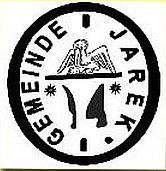the reconstruction of Jarek
The Historical Development of Jarek
(Bački Jarak, Tiszaistvanfalva) in Batschka
4. The Reconstruction of the Village Jarek
by Inge Morgenthaler (nee Schmidt)
translated by Eleonore Oreskovich
After returning to their totally destroyed village in 1850, the inhabitants of Jarek first started makeshift repairs on the ruins of their houses. The very unhygienic conditions soon led to a new problem which the completely impoverished villagers had to bear: the cholera broke out.
They realized that they had to build permanent houses again to be able to lead normal lives. But they had no money, and so they had to turn to the "aerar" again to get loans for building their houses.
The community had applied for a common loan of 20.000 guldens for the reconstruction, which had been granted by "His Majesty most graciously".
Now each house owner could apply for a sum in accordance with the size of his land possessions. He was only allowed to spend the money for the construction of a house with barns and stables and the acquisition of farming equipment. For each family a separate promissory note was written out and the house to be built and all the fields entered into the real estate register as security. The owners of half a "session" got 200 guldens, the owners of small houses and the workmen between 80 and 100 guldens. Both husband and wife had to sign the contract. (According to the existing documents of that time there were no settlers cultivating a whole "session”.)
The conditions were that the house had to be insured with a domestic fire insurance and the loan had to be paid off in 7 equal instalments until January 2, 1860, the first instalment being payable on January 2, 1854 already. From that date on 4 percent interest had to be paid on the remaining sum. The interest had to be paid twice a year. If people fell into arrears, the "aerar" could demand the payment of the total remaining sum at once by order of the court.
More than a hundred promissory notes were written out, but not a single debtor was able to fulfil those very severe conditions until the arranged date, they were not even able to pay the arranged interest.
So the debtors were summoned to court and sued. More than 1078 guldens of interest had not been paid, which were now added to the liability of 20.000 guldens. Now a common promissory note amounting to that sum was written out, for which all the debtors together were liable with all their possessions, i. e. their houses and their fields.
All the debtors are listed in a register giving their house numbers, names and size of their real estate. Therefore the register is interesting for ancestor research, too, because it gives information about the families residing at Jarek at that time. (loc. cite pp. 27 - 35)
e. g.: HN 3 and real estate register number 4 with ½ "session owned by Johann Fix at Jarek . . . . . signature: Johann Fix
Most of the debtors owned half "sessions”, so they had 21 yokes (20 yokes of fields and pastures and 1 yoke for the house and garden), there were only 3 owners of ¼ "session" (13 yokes), but also settlers who only had a house with a “Tretplatz” (“treading place”, threshing area) and vineyard or a house only.
Agreements were made for 12 instalments to be paid per year as well for the 20.000 guldens as for the old interest. The new interest amounted to only 2 percent annually. But again there was the passage, that the total sum would be payable at once, as soon as one instalment was in arrears.
It looks as though these less severe conditions had been fulfilled. The interest was only half as much as before, and the amortization period was 12 years instead of 8 years as before. There is no new promissory note, and it is not known either that the whole village with all the houses and fields had devolved upon the public treasury.
On the contrary, the diligent and hard-working farmers enlarged their village steadily, but all the same the arable land (1.800 yokes) was not sufficient for the growing population, and many young people moved to surrounding villages.
__________________________________________________________________________________
(Link to: “Jarek as Lutheran Centre / Mother Community”)
(Link to: “The Village of Jarek”)
____________________________________________________________________________________
Source: Schmidt J. et al., Batschki Jarak-Jarek, Werbas 1937
__________________________________________________________________________________
Download for the "pdf-file":
__________________________________________________________________________________
